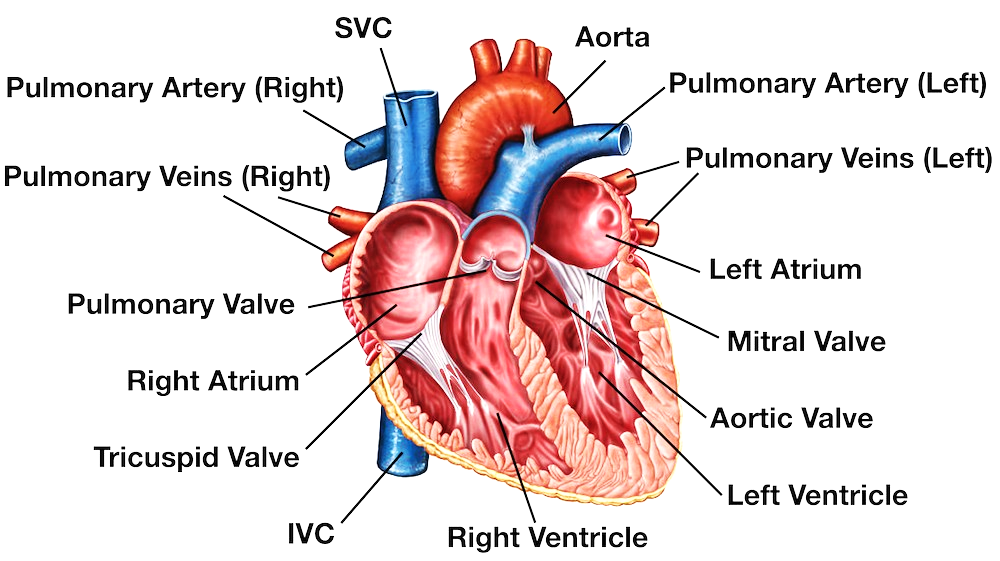Transportation in Human Beings
Transportation
➥ The process of moving essential substances (nutrients, gases, waste) throughout the body.
Importance: Maintains homeostasis and supports cellular functions.
The Heart
➥ A muscular organ responsible for pumping blood throughout the body.
Location: Situated between the lungs, slightly left of the center of the chest.
➯Chambers of the Heart
Atria (Singular: Atrium):
➥ The two upper chambers of the heart.
Function: Receive blood from the body and lungs.
- Right Atrium: Receives deoxygenated blood from the body.
- Left Atrium: Receives oxygenated blood from the lungs.
Ventricles:
➥ The two lower chambers of the heart.
Function: Pump blood out of the heart.
- Right Ventricle: Pumps deoxygenated blood to the lungs.
- Left Ventricle: Pumps oxygenated blood to the rest of the body.
Movement of Blood through the Heart
- Deoxygenated blood enters the right atrium from the body via veins.
- Blood flows from the right atrium to the right ventricle.
- The right ventricle pumps blood to the lungs for oxygenation.
- Oxygenated blood returns to the left atrium from the lungs.
- Blood flows from the left atrium to the left ventricle.
- The left ventricle pumps oxygenated blood to the body through the aorta.
Blood Vessels
➥ Tubes that carry blood throughout the body.
a. Arteries
➥ Carry oxygenated blood away from the heart to the body (except for pulmonary arteries).
Characteristics:
- Thick walls to withstand high pressure.
- Elastic and muscular.
b. Veins
➥ Carry deoxygenated blood back to the heart (except for pulmonary veins).
Characteristics:
- Thinner walls compared to arteries.
- Contain valves to prevent backflow of blood.
c. Capillaries
➥ Connect arteries and veins; facilitate the exchange of gases, nutrients, and waste between blood and tissues.
➥ Microscopic, one-cell-thick walls for efficient diffusion.
Composition of Blood
a. Plasma
➥ The liquid component of blood.
Function: Transports nutrients, hormones, proteins, and waste products.
b. Red Blood Cells (RBCs)
➥ Carry oxygen from the lungs to body tissues and return carbon dioxide to the lungs.
Characteristics:
- Contain hemoglobin, a protein that binds oxygen.
- Disc-shaped and lack a nucleus.
c. White Blood Cells (WBCs)
➥ Part of the immune system; fight infections and foreign substances.
Characteristics:
- Larger than RBCs and have a nucleus.
- Types include lymphocytes, neutrophils, and monocytes.
d. Platelets
➥ Play a crucial role in blood clotting to prevent bleeding.
➥ Small cell fragments produced from megakaryocytes in the bone marrow.
Function of Blood
- Transport: Carries oxygen, carbon dioxide, nutrients, hormones, and waste products.
- Regulation: Maintains body temperature, pH levels, and electrolyte balance.
- Protection: Contains WBCs and antibodies that fight infections.
Blood Pressure
➥ The force exerted by circulating blood on the walls of blood vessels.
Measurement: Given in two numbers (systolic/diastolic).
- Systolic Pressure: Pressure during heartbeats (when the heart pumps).
- Diastolic Pressure: Pressure when the heart is at rest between beats.
- Normal Range: Typically around 120/80 mmHg.
Excretion in Human Beings
➥ The process of removing waste products from the body.
Organs Involved:
- Kidneys: Filter blood to produce urine, removing excess salts, water, and waste.
- Liver: Converts harmful substances into less toxic forms for excretion.
- Lungs: Remove carbon dioxide produced during respiration.
- Skin: Excretes waste through sweat.
Excretion System in Humans
➥ The excretion system is responsible for removing waste products from the body to maintain homeostasis.
a. Kidneys
➥ Filter blood to remove waste products and excess substances, producing urine.
➥ Bean-shaped organs located on either side of the spine. Contain functional units called nephrons.
b. Ureters
➥ Tubes that transport urine from the kidneys to the urinary bladder.
➥ Each kidney has one ureter. Use peristaltic movements to move urine.
c. Urinary Bladder
➥ A muscular sac that stores urine until it is expelled from the body.
Characteristics: Can expand to hold about 400-600 mL of urine. Signals the brain when full, prompting urination.
d. Urethra
➥ The tube through which urine is expelled from the body.
➥ Shorter in females than in males. Has sphincters to control the flow of urine.
How Urine is Formed
➥ Urine is formed through a three-step process:
a. Filtration
Occurs in the glomerulus of the nephron, where blood is filtered to remove waste and excess substances.
b. Reabsorption
Essential nutrients and water are reabsorbed back into the blood from the renal tubules.
c. Secretion
Additional waste products are secreted from the blood into the tubules for elimination.
Composition of Urine
➥ Urine is primarily composed of:
- Water: About 95% of urine.
- Urea: A waste product formed from the breakdown of proteins.
- Creatinine: A waste product from muscle metabolism.
- Electrolytes: Such as sodium, potassium, and chloride.
- Other Waste Products: Including uric acid and various metabolites.
Excretion in Plants
➥ Plants excrete waste products through:
a. Gaseous Exchange
Oxygen and water vapor are released through stomata during photosynthesis and respiration.
b. Waste Storage
Some waste products, like resins and tannins, are stored in vacuoles or excreted from plant tissues.
Transport of Substances in Plants
Transport in plants occurs through:
a. Xylem
Transports water and minerals from the roots to the rest of the plant.
b. Phloem
Transports organic compounds, mainly sugars, from the leaves to other parts of the plant.
Subscribe to My Channel








0 Comments